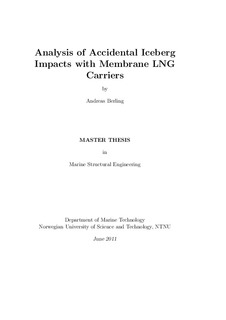| dc.description.abstract | The topic of this report is accidental iceberg collision with the bow shoulder area of a 150000ton membrane-type LNG carrier. It is expected that the traffic of LNG-carriers will increase in the arctic areas in the years to come, and ice collisions are considered to be a real hazard.
A finite element model of the ship side have been developed, where the area in question is the foremost tank of the ship. The collision point is assumed to be in the forward part of the tank, close to the collision bulkhead. However in the FE-analyses the collision point is moved to the centre of the tank, to avoid interference from the boundary conditions.
A maximum size criterion for icebergs is used, where it is assumed that all icebergs with less than 2 meter sailing height are hazardous. This means that the ship is assumed to hit these iceberg at its cruising speed of 19.5 knots. 2 meter sail height corresponds to 5 meter radius for a spherical iceberg.
The steel material used is based on power-law formulations. This allows the material model to take into account increase in stress due to reduction in cross-section area.
The ice material uses the elliptical Tsai-Wu yield surface. Elements are deleted when they violate the fracture criterion.
The FE-analyses are carried out to find the critical energy levels. The analyses were done with spherically shaped icebergs, with radii of 1,2,5 and 10 meter. Failure of the ship structure is based on preventing the gas from leaking out due to fracture of the membranes in the cargo containment system. The criterion which is used is 700mm deection of the inner hull in the middle of the tank. The internal energy for the ship structure when the failure criterion is reached is found to be approximately 70MJ.
The actual collision energy levels are found using a 3D external mechanics model. The results indicate that the critical energy levels are not reached. The levels for 1 and 2 meter radius icebergs are negligible. For the 5 meter radius the level is 8MJ, or 11% of the critical value. For the 10 meter iceberg the margin is quite small, with 57MJ or 81% of critical value. The critical size is found to be 11 meter radius, although it is very conservative since icebergs larger than 5 meter radius will probably be detected before impact.
In previous studies of ship-iceberg impacts, inner hull accelerations are found to be very high, up to 2000g. There has also been concern about accelerations causing problems far from the impact zone. The accelerations have been investigated on several location on the inner hull, and none show higher levels than 200g. Displacements corresponding to these accelerations show no rapid jumps or fluctuations in the curves. This should indicate that the accelerations cause no serious problems for the membrane and are more of a numerical issue than a real life problem.
| nb_NO |
